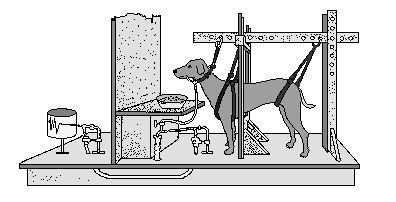CLASSICAL CONDITIONING:
Definition:
Classical conditioning is when two stimuli are presented presented to an animal at the same time, and eventually the same response is made to either stimulus alone:
- A stimulus is applied and the animal makes an innate response.
- Then the stimulus is presented at the same time as another stimulus (this will become the "conditioned stimulus"), and the animal makes the same innate response.
- Eventually the animal will respond to the conditioned stimulus alone, making a conditioned response.
Example:
Pavlov experimented on dogs,
First Experiment.
- He gave the dogs meat powder (stimulus), and measuring the amount of saliva produced (salivation was a reflex response to the meat powder).
- He found that the dogs produced more saliva when given the meat powder.
- He rang a bell, and measured the amount of saliva produced.
- He found that there was no change in saliva produced.
Second Experiment.
The dogs were associating the sound of the bell with the food and salivating as a response. They had been conditioned to respond like this.
- The meat powder was the unconditioned first stimulus.
- Salivating in response to the meat was the unconditioned innate
response
- Salivating in response to the bell alone was the conditioned response
- The bell was the conditioned stimulus.
Benefits of Pavlovian Conditioning to animals.
All animals, including humans, are born with a limited set of reflexes. A reflex is a relationship between a specific environmental event (a stimulus) and a fixed behavioral action (a response) that it evokes.
Reflexes have enormous survival value. They are very important for survival and reproduction. They are not learnt, they are innate and inherited with an organisms genes.
Those individuals who have the best innate reflexes have the best chance of survival.
Individuals who have the capacity to modify their genetically predetermined reflexes, have an even better chance of survival and reproduction.
This is the survival value of Pavlovian conditioning.
Pavlovian conditioning is the fundamental building block of learning. It is basic to the way animals adapt to their environment. It is shown by virtually all animals, from simple multicellular organisms such as flatworms (Planaria) to humans. There is even evidence that single-celled animals are capable of Pavlovian conditioning.
